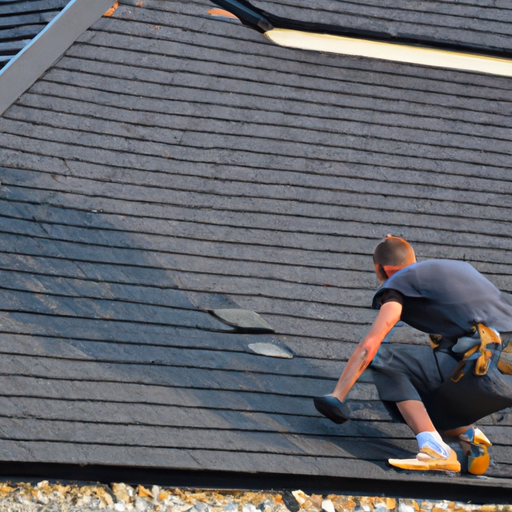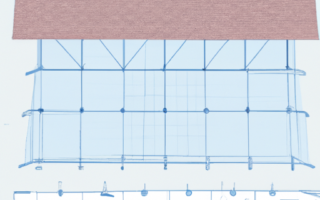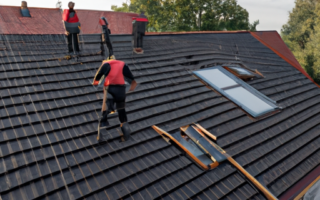Types of Roofing Materials: A Guide to Choosing the Right Option for Your Construction Project
When it comes to choosing the right roofing materials for your construction project, there are a variety of options available. Each type of roofing material has its own advantages and disadvantages, so it’s essential to consider your specific needs and budget before making a decision. In this guide, we will explore the different types of roofing materials and provide insights to help you select the right option for your project.
1. Asphalt Shingles
Asphalt shingles are one of the most popular roofing materials due to their affordability and versatility. They come in a wide range of colors and styles, making them suitable for various architectural designs. Additionally, asphalt shingles are relatively easy to install and maintain. However, they have a shorter lifespan compared to other roofing materials and may not be as durable.
2. Metal Roofing
Metal roofing offers excellent durability and longevity, making it a popular choice for both residential and commercial buildings. Metal roofs are resistant to fire, pests, and rot, and they can withstand extreme weather conditions. They also provide energy efficiency benefits by reflecting the sun’s rays, reducing cooling costs. However, metal roofing can be more expensive than other options, and it may require professional installation.
3. Clay Tiles
Clay tiles are known for their distinctive appearance and durability. They can withstand high winds, fire, and UV rays, making them suitable for areas prone to harsh weather conditions. Clay tiles are also energy-efficient and environmentally friendly. However, they are heavy and require additional structural support. Clay tiles can also be more expensive, and their installation may be more complex.
4. Slate Roofing
Slate roofing is a premium option that offers elegance and durability. It has a unique natural appearance and can last for several decades when properly maintained. Slate roofs are fire-resistant, environmentally friendly, and require little maintenance. However, they are one of the most expensive roofing materials and may require specialized installation and repair techniques.
5. Wood Shakes
Wood shakes provide a rustic and natural look to any structure. They often come from sustainably sourced materials, making them an environmentally friendly choice. Wood shakes offer good insulation properties and can withstand strong winds when properly installed. However, they require regular maintenance, treatment for rot and pests, and may not be suitable for fire-prone areas.
Choosing the right roofing materials for your construction project can significantly impact its overall look, durability, and costs. Consider factors such as budget, climate, building design, and maintenance requirements when making your decision. Consulting with roofing professionals can also provide valuable insights and recommendations tailored to your specific project needs.
Factors to Consider When Selecting Roofing Materials for Your Building Project
When it comes to designing and constructing a building, one of the most crucial decisions you’ll have to make is choosing the right roofing materials. The type of roofing material you select plays a significant role in the overall performance, aesthetics, and durability of your project. It’s important to carefully consider several key factors before making your final decision.
First and foremost, you need to assess the climate and weather conditions in the area where your construction project is located. Different roofing materials have varying levels of resistance to extreme heat, cold, wind, rain, and snow. For example, in areas with high temperatures and intense sunlight, a material with good heat reflectivity and UV resistance, such as metal or asphalt shingles, may be ideal. On the other hand, in regions with heavy snowfall or frequent hurricanes, a durable and impact-resistant material like concrete tiles or slate may be more suitable.
Another crucial factor to consider is the lifespan and maintenance requirements of the roofing materials. Some materials, such as metal and concrete, are known for their longevity and minimal maintenance needs. Conversely, materials like wood shakes or asphalt shingles may require more frequent inspections and repairs. The cost of maintenance and replacement should also be factored in when making your decision, as it can significantly impact the overall budget of your project.
Aesthetic considerations cannot be ignored either. The roofing material you choose should complement the architectural style and overall design of your construction project. Different materials offer various colors, textures, and profiles, allowing you to achieve the desired visual appeal. It’s crucial to strike a balance between aesthetics and functionality to create a visually pleasing and durable roofing system.
Lastly, you should take into account the local building codes and regulations. Certain areas have specific requirements regarding the type of roofing materials allowed, especially in terms of fire resistance and energy efficiency. It’s essential to ensure that your chosen materials comply with these regulations to avoid any legal issues or complications during the construction process.
By carefully considering these factors, you can make an informed decision when choosing the right roofing materials for your construction project. Remember that each project is unique, and what works for one may not necessarily be the best choice for another. Consulting with professionals and experts in the field can provide valuable insights and guidance in selecting the most suitable materials for your specific project needs.
Comparing Different Roofing Materials: Pros and Cons for Your Construction Project
When it comes to choosing the right roofing materials for your construction project, there are numerous options available in the market. Each roofing material comes with its own set of pros and cons, making it crucial to consider several factors before making a decision. In this article, we will compare different roofing materials and discuss their advantages and disadvantages.
1. Asphalt Shingles: Asphalt shingles are one of the most common roofing materials due to their affordability and ease of installation. They are available in a wide range of colors and styles, making them suitable for various architectural designs. However, asphalt shingles have a shorter lifespan compared to other materials and may require regular maintenance.
2. Metal Roofing: Metal roofing is known for its durability and longevity. It can withstand severe weather conditions such as heavy rain, snow, and strong winds. Metal roofing also offers energy efficiency by reflecting sunlight, reducing heat absorption. On the downside, metal roofs can be costly, and the installation process may require professional expertise.
3. Clay Tiles: Clay tiles are popular for their aesthetic appeal and durability. They can add a unique, Mediterranean-style look to your construction project. Clay tiles have excellent insulation properties and are resistant to fire, insects, and rot. However, they are relatively heavy and may require additional structural support. Clay tiles can also be expensive compared to other roofing materials.
4. Wooden Shingles: Wooden shingles or shakes provide a natural and rustic look to any building. They are eco-friendly and biodegradable. However, wooden shingles require regular maintenance to prevent rot, mold, and insect infestation. They are also susceptible to fire and may not be suitable for areas prone to wildfires.
5. Slate: Slate roofing offers a timeless and elegant appearance. It is highly durable and can last for decades without requiring much maintenance. Slate is resistant to fire, rot, and insects. However, it is one of the most expensive roofing materials, and its weight may pose challenges during installation.
Choosing the right roofing material for your construction project depends on various factors such as cost, durability, aesthetics, and climate. It is essential to consult with professionals and consider your specific requirements before making a decision. By analyzing the pros and cons of different roofing materials, you can ensure that your construction project has a reliable and long-lasting roof.
The Impact of Roofing Materials on Energy Efficiency: Making an Informed Decision for Your Project
In today’s world, where energy efficiency is becoming increasingly important, it is essential to make informed decisions when choosing roofing materials for your construction project. The type of roofing material you select can have a significant impact on the energy efficiency of your building, affecting both its environmental footprint and the energy costs associated with it. Therefore, it is crucial to consider various factors before making your final decision.
One of the primary factors to consider when evaluating the energy efficiency of roofing materials is their ability to reflect sunlight, also known as solar reflectance. Roofing materials with high solar reflectance can reflect a large portion of the incoming solar radiation, reducing heat transfer to the building and keeping it cooler. This, in turn, can lower the need for air conditioning and reduce energy consumption, particularly during hot summer months.
Additionally, the thermal emittance of roofing materials should be taken into account. Thermal emittance refers to a material’s ability to radiate absorbed heat back into the atmosphere. Roofing materials with high thermal emittance can release a significant amount of the absorbed heat, helping to keep the building cool. By reducing the amount of heat absorbed by the roof, these materials can contribute to energy savings and enhance the overall energy efficiency of the structure.
An effective way to determine the energy efficiency of roofing materials is to look for their Energy Star rating. Energy Star is a voluntary program established by the U.S. Environmental Protection Agency (EPA) that identifies and promotes energy-efficient products. Roofing materials with an Energy Star label have met specific performance criteria and can provide substantial energy savings compared to non-certified options.
When choosing the right roofing materials for your construction project, it is crucial to consider the local climate and weather conditions. For instance, in regions with hot summers and mild winters, materials with high solar reflectance and thermal emittance are recommended to minimize cooling costs. On the other hand, in areas with cold winters, roofing materials that can retain heat and reduce heat loss should be prioritized to enhance energy efficiency.
Remember that the cost of roofing materials is not the only factor to consider. While certain materials may have a higher upfront cost, the long-term energy savings they offer can outweigh the initial investment. Conducting a life-cycle analysis that considers both the initial cost and the energy efficiency of different roofing options can help you make an informed decision that aligns with your project’s goals.
Ultimately, by choosing the right roofing materials that prioritize energy efficiency, you can contribute to a greener and more sustainable future while enjoying reduced energy costs. Consider consulting with roofing experts and energy efficiency professionals who can guide you in making the best choice for your construction project.



